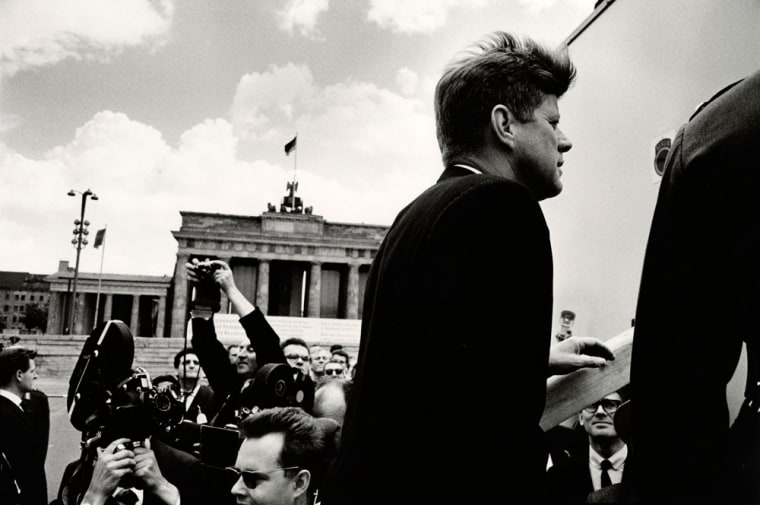The day John F. Kennedy visited Berlin, Klaus Schuetz sensed something special as he waited in city hall for the U.S. president’s arrival. Thousands of people, some with tears in their eyes, chanted Kennedy’s name along the motorcade route and packed the square outside.
“I have never seen the city vibrate the way it did on this day,” said Schuetz, an official in Mayor Willy Brandt’s administration at the time, and later mayor himself.
For people of Schuetz’s Cold War generation, the emotion of that eight-hour visit, on June 26, 1963, lingers after more than 40 years — one reason why the 35th U.S. president and his family are being commemorated with a new museum opening Saturday in the German capital.
The exhibit of photographs and personal memorabilia includes Kennedy’s black Hermes attache case that he took with him to Dallas on the trip that ended with his assassination, a carved cigar box with his name, and one of Jacqueline Kennedy’s trademark pillbox hats. Other exhibits focus on the family’s origins in Ireland and the careers of other family members.
Photos document the visit — showing Kennedy before the Berlin Wall at the Brandenburg Gate, with then-Chancellor Konrad Adenauer and Brandt, and delivering his famed “Ich bin ein Berliner” or “I am a Berliner” speech that reassured West Berliners, then surrounded by communist East Germany, that the United States would not let them down in a crisis.
Schuetz, now 80, recalled that the city was gripped by “a kind of movement — my children were still relatively small, and at home they were jumping up and down in exactly the same way as the rest of the city, and yelling, ’Kennedy, Kennedy, Kennedy.’
“There was a very special excitement here.”
Schuetz said Berliners — unhappy with what was considered a weak response to the communists’ building of the Berlin Wall in 1961 — wondered if the United States would stand up for them.
“We were a city under threat, and in a threatened city there are, and were, fears,” said Schuetz, seated in the living room of his sunlit, book-lined Berlin apartment.
“And here comes the man who decides the question, and says he is a Berliner, that yes, he belongs to us, and they’ll have to carry him out or get rid of him, that he intends to stay.”
Younger people often don’t understand how tense the times were, Schuetz said.
“Maybe they read about it in school. But for those over 50, Kennedy is one of the great ones, and always will be.”
The private museum’s organizers, photo gallery Camera Work AG, say they expect a strong response to the exhibit, which attracted thousands when it was shown in Rome in 2005.
The location on Berlin’s Pariser Platz, next to the Brandenburg Gate, is “incredible,” said Andreas Etges, a scholar at the John F. Kennedy Institute of North American Studies at Berlin’s Free University who is curating the historical aspects of the exhibit.
“When you walk out of the museum, you stand in front of the Brandenburg Gate and Kennedy was just on the other side,” he said.
The museum is a testimony to the remarkable persistence of Kennedy’s memory in Berlin and Germany — and a sharp contrast to the skeptical view among many Germans of the Iraq war and President Bush.
A 2003 survey by the Allensbach organization showed that, when Germans were asked to say what most determined their view of the United States, 53 percent mentioned the Kennedy visit — ahead of 44 percent mentioning the Vietnam War, 43 percent pop music and 40 percent the Berlin airlift, in which a U.S. air bridge foiled a Soviet attempt to starve out West Berlin.
The president’s assassination on Nov. 22, 1963, led to an outpouring of sympathy and renaming of public places. John F. Kennedy squares and streets are scattered across Germany, while Berlin has the bilingual, public John F. Kennedy School.
Charisma aside, historian Andreas Daum of the University at Buffalo, State University of New York, said subsequent political change made it difficult for later U.S. presidents to duplicate Kennedy’s emotional connection with Berliners. They included Ronald Reagan, who also visited the Brandenburg Gate and urged Soviet leader Mikhail Gorbachev to “tear down this wall” in 1987, and Bush in 2002.
Kennedy was lucky to face a situation where U.S. and German interests overwhelmingly matched, said Daum, author of “Kennedy in Berlin,” a study of the visit. America was viewed in a more unabashedly positive way before the Vietnam War and the student protest movement in the 1960s.
“He certainly caught the mood of the moment,” Daum said. “It was the moment where rhetoric, charisma and policies seemed to be congruent — and that moment has never been repeated.”
The museum “The Kennedys” is open daily 10 a.m. to 6 p.m.. Admission is $8.93, $4.49 for seniors and students.
